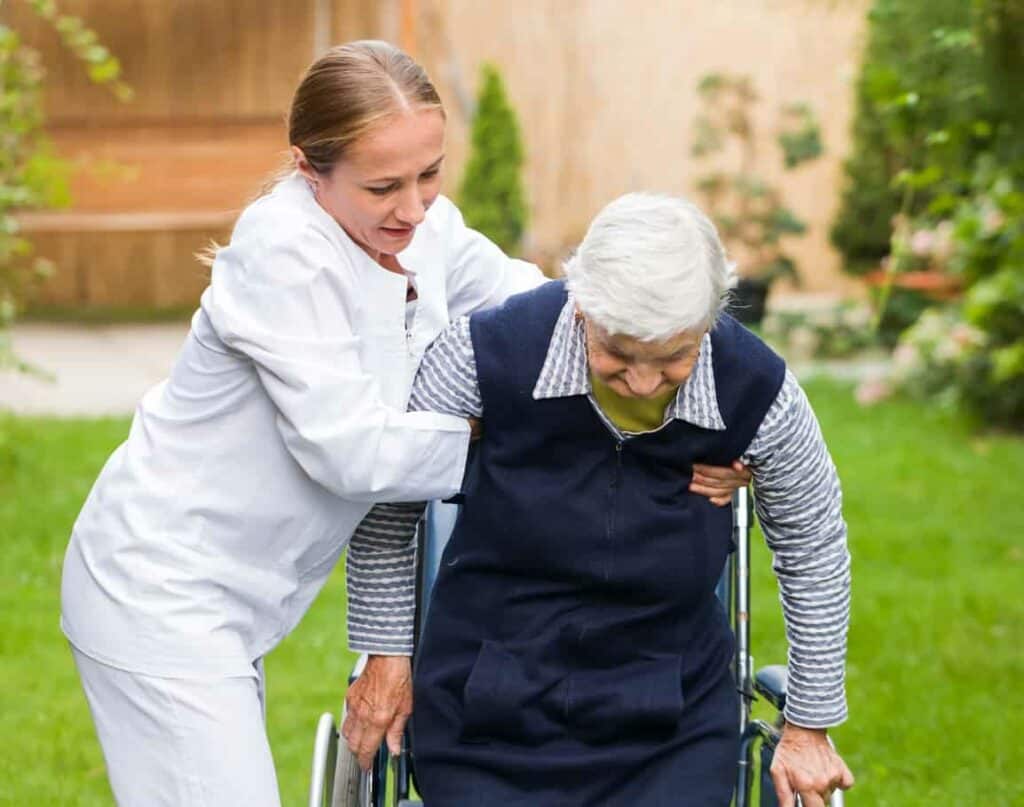Family Survey
Family Survey Please share your honest feedback to help us improve the care and safety of your loved one.
Are you providing care for a loved one with limited or no mobility? Perhaps your beloved is bedridden and confined to their room day and night?
Then, you know firsthand how difficult it is to help them transition around the house or even around the room.
Every simple movement from bed to couch, for example, can turn into an awkward and tiresome exercise requiring tremendous physical strength on your part and loss of self-assurance on your loved one.

The Hoyer lift, a sophisticated and invaluable assistive device, was designed to safely and efficiently transfer individuals with limited mobility like your beloved. Named after its inventor, Ted Hoyer, it has become an essential tool in healthcare settings and home care environments.
This article aims to explain how to safely use this device while also highlighting some challenges it poses and suggesting ideas on how to overcome them.
The Hoyer lift also called a patient lift comprises a robust metal frame with a movable arm, often referred to as a “boom,” attached to a secure harness or sling.

The Hoyer lift may be powered by electricity, making it effortless to use. The lift’s boom and sling system gently and securely cradles the senior, providing a sense of safety and reassurance during transfers.
Caregivers can control the lift using a simple set of buttons or a remote control, ensuring smooth and steady movements and saving themselves a lot of heavy lifting.
Hoyer lift’s versatility makes transfers between a variety of surfaces – from a bed to a wheelchair, a chair to a commode, or even the floor seamless and easy.
This adaptability is a hallmark feature, catering to the diverse needs of individuals with varying mobility challenges.
The main function of a Hoyer lift lies in its ability to provide safe and dignified transfers for both the individuals and their caregivers.
It alleviates the physical strain placed on caregivers during transfers, reduces the risk of injuries, and ensures the well-being of both parties.
Additionally, the secure harness or sling system offers comfort and reassurance to your loved one during the transfer process.
In essence, a Hoyer lift is a sophisticated, electrically powered device that promotes safety, independence, and comfort for individuals with mobility limitations.
It enables caregivers to provide essential support without the physical strain and risk of injury, making it a valuable asset in healthcare facilities and a heartening addition to home care environments.
The impact of a Hoyer lift exceeds its mechanical components in the following ways.
It affects the quality of care, respect, and quality of life for those it serves. It can be a game-changer when it comes to ensuring the safety, comfort, and dignity of older adults who are bedridden or may struggle with mobility challenges.

Hoyer Lift empowers seniors to move with grace and ease, allowing them to transition from their bed to a wheelchair, a chair, or even a commode. This newfound mobility can work wonders for their sense of independence and well-being.
Caregivers find immense relief in the use of a Hoyer lift as well. The lift takes the physical strain out of lifting and transferring seniors, reducing the risk of injury to both the caregivers and the seniors. It’s a caregiving ally that lends a helping hand when strength alone may not suffice.
A Hoyer lift can be an indispensable addition to the lives of seniors and their caregivers. It promotes independence, safety, and peace of mind. It’s not just a piece of medical equipment; it elevates the sense of respect, care, and love.
Using a Hoyer lift can be a bonding experience for the caregiver and the person being assisted.
It’s a demonstration of care and trust that allows individuals with limited mobility to feel safe, supported, and valued.
If you are not experienced with using a Hoyer lift, it’s advisable to receive proper training from a healthcare professional. it is also crucial to seek resources, including the manufacturer’s guidelines to understand the full range of models and options available for use.
Let’s look at the step-by-step instructions on how to use this medical equipment.
As you can see, using a Hoyer lift is not just a mechanical operation; it’s an act of care, preserved dignity, and expressed compassion.
The trust and comfort it fosters create a heartwarming connection that goes beyond the physical assistance, reminding us of the profound impact of human touch, kindness, and relationship with one another.
Using a Hoyer lift can be incredibly beneficial, but it can also present some challenges. Overcoming these requires patience, proper training, and a compassionate approach. Here are the most common difficulties and ways to address them:

One of the key challenges is ensuring that the sling is positioned correctly under the individual. If it’s not properly placed, it can be uncomfortable and may even cause skin irritation.
To overcome this, make sure you receive proper training on sling placement and double-check the positioning before starting to lift. Feel free to contact a professional caregiver or physiotherapist at Amy’s Eden, who can provide you with detailed advice and instructions.
Always communicate with your loved one during the process to ensure their comfort.
Safety is paramount when using a Hoyer lift. Challenges may include ensuring the lift is on stable ground, preventing tipping, using the right sling for the patient’s weight, and securing the individual in the sling.
To address safety concerns, always confirm the Hoyer lift is on a flat and stable surface.
Use safety belts and straps to secure the individual, and double-check that all locks and latches are engaged.
Some people may experience anxiety or fear during the transfer process, especially if it’s their first time using a Hoyer lift.
To overcome this challenge, communicate openly and reassuringly. Explain each step of the process, offer a hand to hold, and make sure your beloved feels heard and understood.
Using a Hoyer lift can still require significant physical effort from caregivers, especially when moving the individual into the correct position for the sling.
To address this, you should receive proper training in lifting techniques to minimize physical strain.
Additionally, consider using a Hoyer lift with powered features, such as powered legs or an adjustable base, to reduce manual effort.
Effective communication is vital when using a Hoyer lift because the device can look intimidating at first. Ensuring the individual understands the process and is comfortable during the lift transfer is essential.
Overcome communication challenges by maintaining eye contact, speaking clearly and calmly, and using non-verbal cues like gestures and nods.
Maintaining your loved one’s dignity and emotional well-being is crucial since being suspended in a sling can be emotionally challenging.
To overcome this, approach the process with empathy and sensitivity.
Explain each step, ask for their preferences, and provide reassurance and comfort throughout.
Hoyer lifts require regular maintenance to continue functioning safely and correctly. Challenges can arise when equipment is not properly maintained.
It helps to establish a routine maintenance schedule and conduct regular inspections to identify and address any issues. Follow the manufacturer’s guidelines for care and maintenance.
Transferring the individual between different surfaces, such as from a bed to a wheelchair, can be a challenge due to the differences in heights.
The best solution is to choose patient lifts with adjustable features and consider using transfer boards or slide sheets to facilitate smoother transfers.
Proper training and practice for both caregivers and patients using the lift is essential. In addition, clear communication, ongoing assessment of individual needs, and equipment maintenance are key components in ensuring safe and comfortable transfers with a Hoyer lift.
Having a Hoyer lift to assist you in the caregiving duties for a loved one with challenged mobility can be a godsend. However, thoroughly reading the manual, getting familiar with the instructions for use, and following the seven steps listed in this article will ensure the safety and comfort of all involved in lift transfers.
Please make sure that you are aware of the technical capabilities and requirements of the equipment and have tested the functionality before you make any transfer attempts of your beloved.
If you have any doubts about its use or you would like to arrange additional professional care for your family member, we at Amy’s Eden are one phone call away. Contact us at (775) 884-3336 or online by filling out the form here.
Get care >
Family Survey Please share your honest feedback to help us improve the care and safety of your loved one.
Professional Senior In-Home Care in Carson City Keep your loved one in the comfort of their cherished home. Amy’s Eden delivers exceptional senior care services

The Best Home Care in Reno, NV The comfort of your home, the quality of Eden. We provide compassionate, professional in-home care services for seniors
A Real Home for Assisted Living in Carson City, NV Give your loved one the exceptional, personalized care they deserve. Our senior care homes in

Amy's Eden Senior Care © 2023